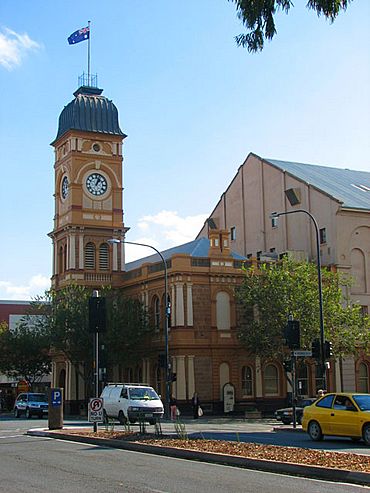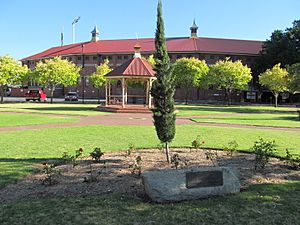Norwood, South Australia facts for kids
Quick facts for kids NorwoodAdelaide, South Australia |
|||||||||||||||
|---|---|---|---|---|---|---|---|---|---|---|---|---|---|---|---|

The Norwood Town Hall on The Parade
|
|||||||||||||||
| Population | 5,953 (2016 census) | ||||||||||||||
| Established | 1847 | ||||||||||||||
| Postcode(s) | 5067 | ||||||||||||||
| Location | 4 km (2 mi) from Adelaide | ||||||||||||||
| LGA(s) | City of Norwood Payneham & St Peters | ||||||||||||||
| State electorate(s) | Dunstan | ||||||||||||||
| Federal Division(s) | Sturt | ||||||||||||||
|
|||||||||||||||
Norwood is a suburb of Adelaide, about 4 km (2.5 mi) east of the Adelaide city centre. The suburb is in the City of Norwood Payneham & St Peters, whose predecessor was the oldest South Australian local government municipality.
Contents
History
Norwood is named after Norwood, London. It was first laid out in 1847.
Geography
The suburb consists of four segments, being divided into north and south by the major thoroughfare of The Parade and east and west by Osmond Terrace. It is bounded on the south by Kensington Road, on the north by Magill Road, on the east by Portrush Road and on the west by Fullarton Road. It is a leafy suburb many of whose streets are lined with plane trees and older houses, though in recent years, due to a State Government initiative of "urban-infill", there have been more higher density (by Adelaide standards) developments. It is now a sought-after suburb to live in, but this was not always the case.
Osmond Terrace is a street with a wide median strip featuring a prominent war memorial commemorating ANZAC soldiers who fought in the first and second World Wars.
The most visible landmarks in Norwood are the Norwood Town Hall and the Clayton-Wesley Uniting Church (previously Clayton Congregational Church) on the north east corner of Portrush Road and The Parade. Actually located in Beulah Park, the church, built over 150 years ago, is visible all the way up The Parade.
Demography
| Historical population | ||
|---|---|---|
| Year | Pop. | ±% |
| 2001 | 5,358 | — |
| 2006 | 5,704 | +6.5% |
| 2011 | 5,802 | +1.7% |
| 2016 | 5,953 | +2.6% |
Norwood attracted many European migrants post-World War II, in particular Italians. In the 2016 Australian census, 4.1% of the population spoke Italian at home, with Greek coming a close second at 3%. By the 2016 Australian census, the top language other than English spoken at home was Mandarin Chinese, at 3.6%, while 3.2% of the population spoke Italian and 2.8% Greek.
In 2016, there were 5,953 people living in the suburb, with a median income of A$1,485 per week. The top ancestries in 2016 were English, at 26.3% and Australian, at 17%. Only 64.4% were born in Australia, while 43.2% had both parents born in Australia.
Transport
Several Adelaide Metro bus routes serve the suburb. These are the main routes running through or adjacent to Norwood as of 2020[update]:
- H30, H33: Magill Road
- H20, H21, H22, H23, H24, N22: The Parade
- 140, 141,142: Kensington Road
- 300: Suburban Connector (Portrush Road)
In addition to these, there are a number of school services running during term-time, and special services to Adelaide Oval for big events.
Attractions
The queen of Adelaide’s eastern suburbs: hip, sassy and smitten with cafe life.The Parade contains the business centre of the suburb, which includes some professional services but it is better known for its restaurants, cafes, fashion boutiques and hairdressers.
Sport
Norwood Oval
Norwood Oval, as of 2021[update] known as the Coopers Stadium, on The Parade, is home to the Norwood Redlegs, a South Australian National Football League (Australian Rules Football) team It also hosts some AFL Women's (national league) matches, including the Adelaide Crows. It is the former home of Adelaide Bite, an Australian Baseball League team .
Norwood Cycling Club
The Norwood Cycling Club (NCC) is the largest cycling club in South Australia, with 380 members as of 2021[update], and its 1883 foundation date makes it the oldest such club in the southern hemisphere. It was founded as the Norwood Cycle and Motor Club, and its official opening was at Kensington Oval, a bit further up The Parade in the suburb of Kensington, on 4 February 1884. Sir Edwin Smith was a foundation member and patron of the club, which became incorporated in 1918, after it had bought land and built clubrooms at Port Noarlunga. After the Jubilee Cycling Arena was built in Norwood in 1951, the club's members used to race there, and in 1965 the club raised money to concrete the track. Its clubrooms opened in George Street in 1975.
Former members of the club include many champions, including Jack Bobridge, Luke Roberts, Tim Roe, Alexis Rhodes, Tiffany Cromwell, Patrick Jonker, Michael Turtur, David Solari (son of Nino Solari), Wayne McCarney, Charlie Walsh and Jay Sweet.
Each year the club promotes four major cycling events:
- the Noarlunga Road race (since 1919);
- the Burra 2-day Classic;
- the Tour of the Riverland (established 1975); and
- the AlphutteClassic Handicap.
NCC is affiliated with Cycling SA, which is in turn affiliated with the national parent body of the state bodies, Cycling Australia.
Notable buildings
- Norwood Town Hall was heritage-listed on the SA Heritage Register in November 1985.
- Norwood Library is located on 110 The Parade, near the corner of Osmond Terrace, in the old Kensington and Norwood Institute building, which was heritage-listed in 1981 on the South Australian Heritage Register. The institute, designed by government architect W. H. Abbott free of charge, and built in 1876, was one of many mechanics' institutes in Australia established during the 19th century. It was largely funded by its founding president, Sir Edwin Smith. In 1882 its collection, available for loan by subscriptions paid by members, was enhanced by books acquired from the Magill Institute after its demise. In 1883 extensions were added to the building, including a hall and reading room, and in 1895 it also had a musical program. In 1914 the library held 13,744 volumes, and 190 periodicals and newspapers, and an art school was opened in the building. In the 1950s the Institute supported the free lending of books, but fell into debt to the council. In 1977 the City of Kensington and Norwood acquired the building, and carried out renovations, retaining the library. In 1986 the Institute was dissolved, setting up a Friends of the Library group as the building becoming the responsibility of the council. The building was refurbished in period style and became Norwood Library.
- The former Norwood Baptist Church, on the south-eastern corner of Church Avenue and The Parade (no. 134), designed by architect James Cumming, built in 1869 by Charles Farr and opened in January 1870, was heritage-listed on the SA Heritage Register in 1982. Its classical style was particularly influenced by the Metropolitan Tabernacle in Newington Butts in London, where influential Baptist preacher Charles Spurgeon used to preach. The building contains one of the most significant church organs in South Australia, installed in 1882. Its use as a church ceased and for some time it housed the Mary Martin Bookshop, but that closed in the 2010s and has since been used as a restaurant.
Images for kids




